10 Tips for a Low-Maintenance, Eco-Friendly Backyard
Protecting the environment has never been more important, and it can start right in your own eco-friendly backyard. Incorporating eco-friendly design and maintenance into your landscaping will not only help to save the environment, but will also provide a beautiful, inviting yard that is simple to maintain. Incorporate the 10 tips below into your landscape design and soon you will be enjoying a low-maintenance yard that also just happens to make the world a little bit greener.
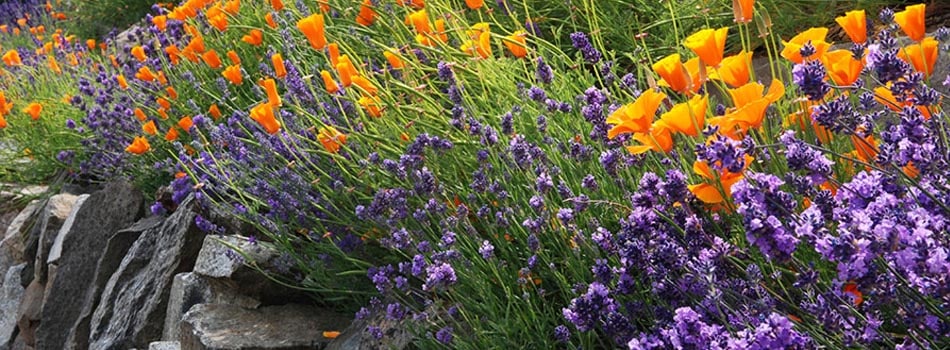
1. Choose native plants
When choosing plants and trees for your yard, look for flora native to your area. Native trees and plants provide habitat for and attract birds, butterflies, and other beneficial local wildlife, and are acclimated to local rainfall amounts and climate. Once established, native plants require very little maintenace because they are naturally resistant to local pests and disease. Because they do not need fertilizers, pesticides, or supplemental watering, they are easy and inexpensive to maintain and are environmentally friendly. For a complete native wildflower guide searchable by color and location, click here.
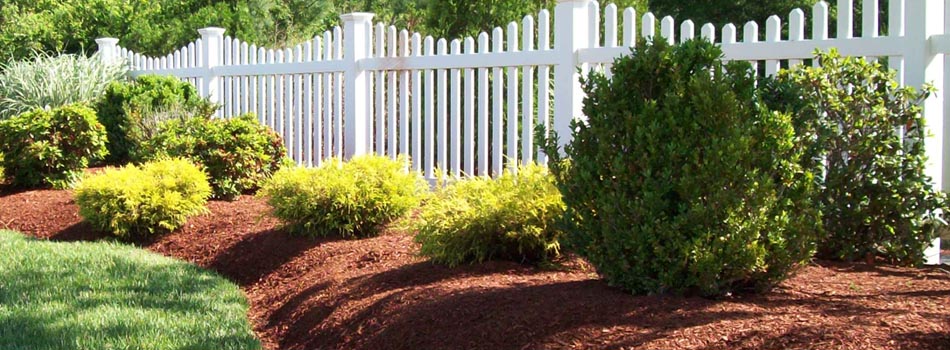
2. Mulch
Organic mulch such as wood chips, bark, leaves, and pine needles provides a host of benefits. Mulch regulates soil temperature and retains moisture, helping to keep plantings alive and healthy, and it also inhibits weed growth in flowerbeds, allowing for easier weeding. As it breaks down, organic mulch has the added bonus of adding nutrients to the soil. Mulching under trees to the drip line not only helps to retain moisture in the root area, but also reduces the footprint of your lawn. Grass lawns are water guzzlers, and incorporating mulch throughout your landscape can reduce outdoor water usage by as much as 50%. To save even more water, consider completely eliminating the lawn…
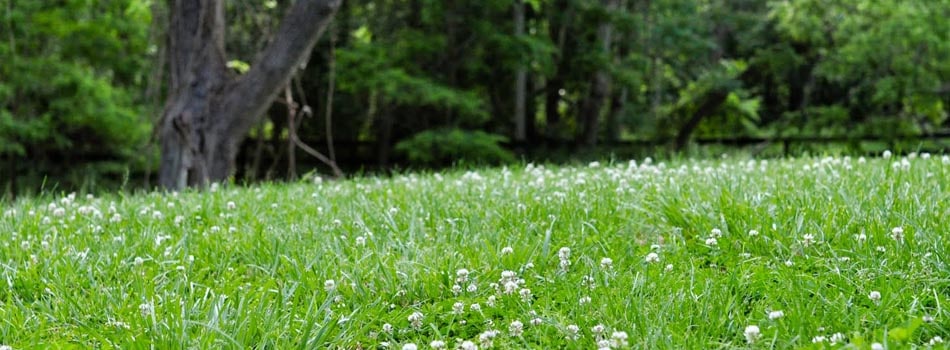
3. Plant ground cover instead of grass
Ground cover has many advantages over grassed lawns. Ground cover hugs the ground and requires little to no mowing, no additional watering, and no pesticides or herbicides. For shady areas, moss makes a beautiful lawn. Moss is green even in the high heat of summer, and feels wonderful under bare feet. Clover is an excellent groundcover for lawns in full sun. It stays green during times of drought, is sweet smelling, feels soft and cushiony underfoot, and helps to prevent soil compaction. If you wish to provide a habitat for bees, you can allow your clover lawn to bloom to attract them. If not, don’t worry – just give your clover lawn an occasional mowing to both promote growth and keep the bees away. Creeping perennials may also be used for groundcover lawns, many of which smell wonderful, need little maintenance, and feel soft underfoot.
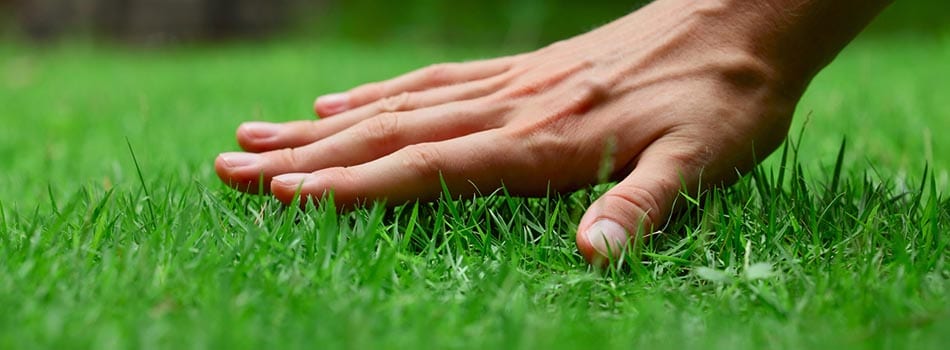
4. Keep your grass high and dry
When mowing, leave the grass higher (cut no more than a third of the total blade length at a time) and mow more frequently. Your lawn will retain more water and be healthier. Also, leave your grass clippings on the lawn. Grass clippings are 75-85% water, rich in nitrogen, and will keep your lawn moist and healthy. If you really can’t bear leaving the clippings on the lawn, you can discard them in your new compost bin…
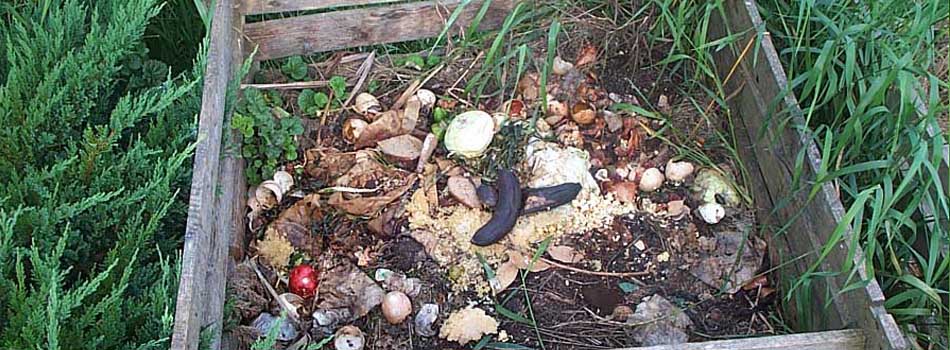
5. Start composting
Composting reduces the amount of garbage we produce and also produces natural, free fertilizer. All you need to start making your own compost is a warm, partly sunny area and some soil. If you wish to keep your compost pile out of sight, you can easily install a compost bin. In your designated area, add a mix of household and garden waste including fruit and vegetable scraps, eggshells, newspapers, wood shavings, weeds, and cardboard. This mix will provide the right environment for compost-making bugs, and within six to nine months, you will have rich, nutritious compost ready for use in your garden. Note: do not discard any animal scraps into your compost. For a complete list of compostable items, click here.
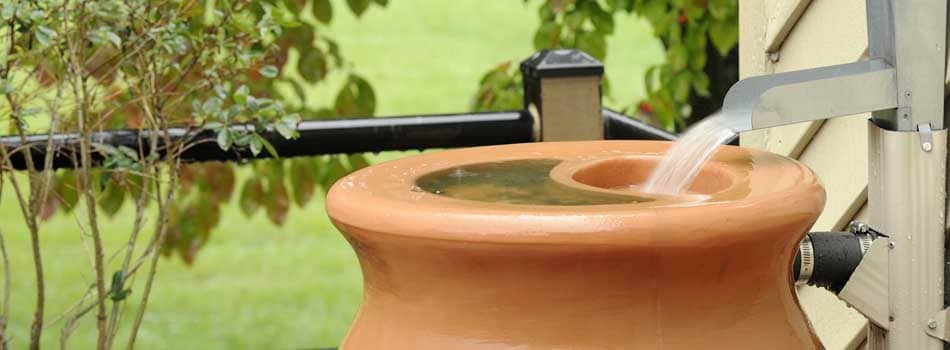
6. Harvest rainwater
Harvesting rainwater is one of the simplest ways to green up your landscape. Harvested rainwater is used to water plants, flowers, and vegetable gardens, greatly reducing the amount of outdoor household water usage. It also captures stormwater runoff from roofs and gutters, which prevents pollution from entering our water supply. Whether you choose to use rain barrels, cisterns, or rain chains, you will be greatly improving your water footprint with the use of a rainwater harvesting system.
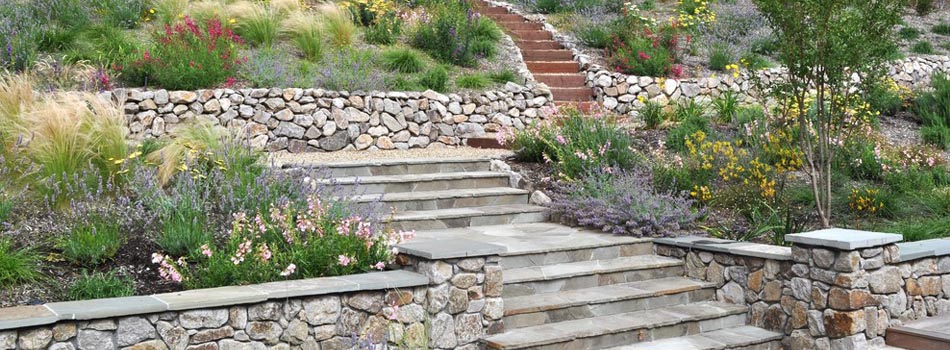
7. Use terraces on slopes
Not only are steep slopes difficult to mow and maintain, they also cause erosion and excessive stormwater runoff, two environmental concerns. However, terracing is an effective and attractive solution to prevent both erosion and runoff. Terracing involves leveling off sections of a steep slope into flat, planted areas that are perfect for flower or herb gardens, or for shrubs and mulch. These flat, planted areas allow rainwater to soak into the beds instead of allowing it to flow down the slope. While they can be somewhat costly to install, terraces are a beautiful and beneficial addition to landscapes.
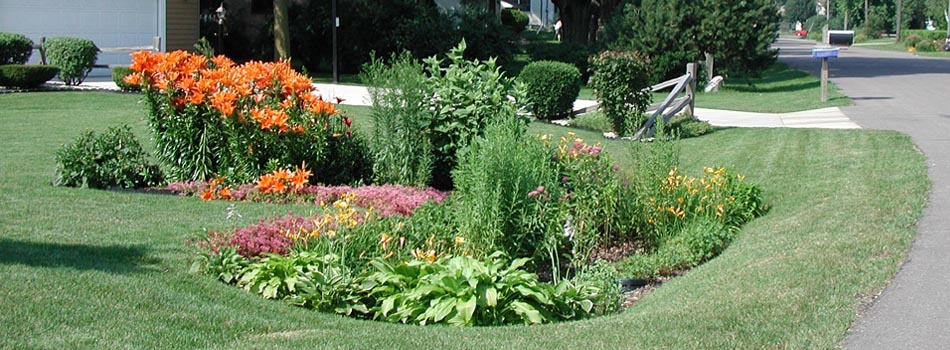
8. Plant rain gardens
Planted specifically where rainwater habitually pools, rain gardens are attractive landscaping elements that capture and filter stormwater. Utilizing native, flood-resistant plants and loosely packed, deep soils, they are able to absorb large amounts of rainwater and filter out pollutants. In addition, rain gardens have the added bonus of decreasing the surface area of your lawn while providing inexpensive, low-maintenance, and appealing landscaping.
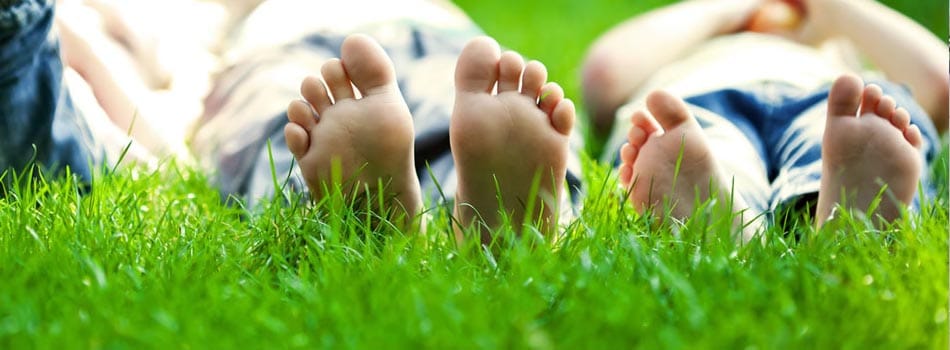
9. Eliminate or minimize the use of fertilizers
Standard lawn care, such as the type purchased at any local hardware store, involves dumping large amounts of chemicals, many simply not needed, onto the lawn. Dubbed “weed and feed,” these quick-release fertilizers and herbicides strip the soil of its nutrients and promote lawn disease, making the lawn dependent on the very chemicals that caused its damaged condition in the first place. A better option is to utilize organic fertilizer, and then use only as much as you actually need (typically this is less than half of what the manufacturer advises). Be sure to sweep up and dispose of any fertilizer that lands on paved or other impervious surfaces, and if you have a well for your drinking water supply, be sure to avoid fertilizing any areas in close proximity to or uphill from it. The best option is to completely eliminate the use of fertilizer and instead add compost and organic matter into your soil, aerate regularly, mow high, and incorporate moss and groundcover into your lawn.
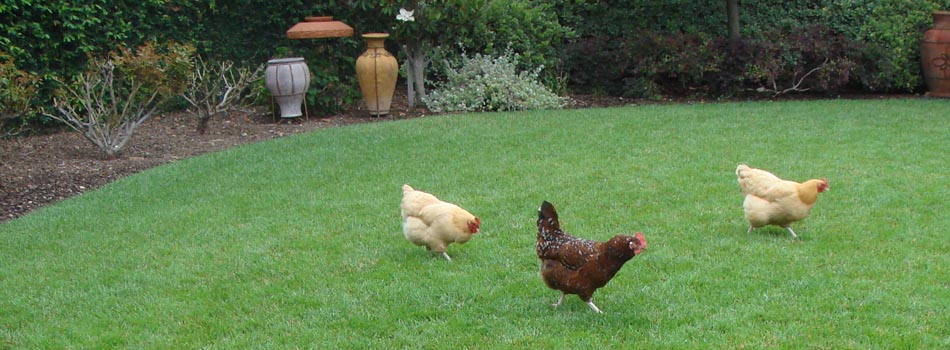
10. Use natural pest control and herbicides
Pesticides have long been known to be detrimental to both the environment and our health. DDT was outlawed in the U.S. in 1972, and Agent Orange is still causing health issues for Vietnam veterans and the Vietnamese population 40 years after the war. In addition, pesticides have recently been linked to the decimation of the bee population, which even the White House and the EPA have acknowledged is cause for concern. The good news is that Integrated Pest Management (IPM) controls unwanted pests in a way that is both sustainable and safe. IPM involves a combination of techniques such as hand-removal of weeds and insects, attracting beneficial insects such as lacewings and praying mantises, selecting native plants that are naturally resistant, and utilizing natural insecticides such as insecticidal soaps and oil sprays for mites, aphids, and mealybugs, and milky spore bacteria for grubs. Slugs can be caught by sinking yogurt cups filled with beer or milk into the ground or by leaving hollowed out grapefruit halves around your plants, and aphids and mites can readily be managed with ladybugs. For those with a truly rural bent, chickens are natural predator of ticks, and, if left free to roam, will gobble up lawn grubs while aerating — and fertilizing — the lawn.
Natural, holistic backyards protect our environment, save money, and, after initial implementation, are easily maintained with minimal effort. Follow these 10 tips and you will soon have a beautiful backyard that requires little maintenance, leaving you time to relax in your hammock knowing that you’ve helped make the world a greener place.

I really appreciate you talking about this. My wife is huge into taking care of our yard, and she was wondering how she could prevent soil erosion. This is been bugging her for a long time, and she just wanted to take care of it now. So thank you for this, it really helped clear up some of her confusion.
These tips were so great that I can’t help but smile upon thinking of the idea on how should I do it with my own garden.
This is a very helpful and useful tip, not only we can prevent soil erosion in our home backyards, but we can also designed it according to our taste.
Its really a big help thank you.
My yard doesn’t hold up very well during the summer, so these tips are really helpful! Using a mulch to conserve water is a great tip. My dirt dries out so fast, that several of my plants have died. What type of mulch would you suggest I look for to keep my dirt nice and moist?
I love your suggestion to prevent soil erosion by terracing the slope. I would love to do that, but you mention it’s rather costly – and I wouldn’t be able to do it myself. Is there any other way to prevent erosion on slopes, like specific products, or some other sort of ground cover?
Where I live now doesn’t have much of a yard but if there was one, I would for sure see about making it look good. Of the ten things that you listed here, I really liked number four. We usually see where people will cut their grass super short for looks, where in reality it is doing more harm than good.
I love the ideas you have for using stormwater runoff in positive ways. Capturing it with rain barrels or chains is a good idea, as is planting a rain garden. It also gives you the added benefit of directing the runoff away from areas where you don’t want excess water to end up, such as around your house or pooling on your lawn.
Thank you for the tip on planting ground cover instead of grass because it requires little to no mowing. My backyard is in serious need of a remodel because of the harsh winter. I was considering doing it myself, but I think I am going to need to hire a professional service to add a patio.
I never would’ve guessed that you can use newspaper as compost in your lawn and garden! I have a lot of old newspaper, and my wife and I usually just recycle the newspaper every week! I will be sure to tell my wife that we can put some of it in our garden to help with the compost!
It really helped when you said that it would be best to choose ground covers instead of grass because it doesn’t need to be mowed and watered. Since my husband and I have busy schedules due to our two businesses, this information is perfect for us because it will keep our backyard appealing without having to worry about it every day. With that in mind, I will be contacting a professional already since I have made up my mind regarding the landscape design that I want for our backyard. Thanks!
My husband is highly allergic to grass so I really loved your suggestion of using a ground cover instead of having a traditional lawn. I think that moss or clover would be a great alternative and you made a great point about how it requires almost not mowing to maintain a yard with ground cover vs grass. We will have to look at a few different ground cover options as we finish our landscaping.
That’s good to know that you shouldn’t cut your grass more than a third of the length and then mow frequently since it’ll make it retain water and be healthier. My husband and I just moved into our first home so I’m trying to figure out how to take care of the grass since neither one of us ever has. We’ll probably look for a landscape company that can help us with maintenance since they’ll probably know the best way to cut the grass and how often we should to make sure it stays green and healthy.
I’ve recently moved into a house with a big yard and I’m very excited to spruce it up with some landscaping. I’d really like to make sure whatever I’m doing in benefiting the environment, so I really appreciate the tips in this article. A rain garden sounds like such a great idea, and they are inexpensive and low maintenance.
It got me when you talked about how storing rainwater will help reduce the water bill while still being able to keep the plants hydrated. I will keep this in mind since I plan to have our lawn landscaped this weekend. We have always wanted to have this design on our minds, but we just don’t have the right amount of money to hire experts.
Since you mentioned that one can keep maintenance low on a backyard while keeping it eco-friendly is to replace fertilizer with compost and organic matter, it gave me an idea. If one were to take care of chickens in order to introduce organic matter to a garden, what kind of plants and trees should not be planted? Are there also shrubs that are dangerous to chickens?
Really cool backyard ideas.! kids friendly backyard helps to development kids social Skill. Though game they can interact with other children. In this way they can lean many think. Thanks for sharing a nice blog with us.
You’ve got some great landscape design tips here. I like how you said that using organic mulch is a great way to make weeding a lot easier. We’re planning our landscape design right now, so I’ll remember what you said about that and our gardens!
I like your idea about incorporating eco-friendly design into your landscaping. It’s a good thing that you discussed tips on how to do it. My mother is planning to landscape our old garden, I will advise her to do this as it’s good for the environment. She is now looking for lawn care services who will help her further.
Thanks for pointing out that if you have a well for your drinking water supply, be sure to avoid fertilizing any areas in close proximity to or uphill from it. My husband and I are thinking about drilling a water well in our backyard because we think that it would help us be more eco-friendly. I also think that it would help us to be a little more self-sufficient. We’ll have to make sure that we read more about taking care of wells so that we can keep it and ourselves in good condition.
I like that you suggest using terracing on slopes to decrease the amount of erosion from rain water. My parents are planning a yard remodel, so I have been looking for ideas to make it more efficient. I will send this information over to them, so they can find a landscape construction company that can get them the yard they want.
While reading your post, I made a mental note of the tips I’m surely going to do. These tips are super simple, but they make sense. Number 10 got me sold. Truly, you’ll never go wrong with natural and organic options! 🙂
Using natural pest and herbicides is really a good idea. Fertilizers are neither good for our lawns and gardens nor our lovely planet. Therefore, try to maintain your garden by using natural methods.
these tips are really eco friendly.. thanks f or sharing this with all
It was interesting to learn that steep slopes tend to lead to erosion in yards. My husband and I have a rather steep yard and now I’m a bit concerned that something could happen. We’ll have to look into hiring a professional to come help with some terracing solutions.
Hi buddy..
As i have go through your whole blog it is really helpful and useful that i must say you did a great work . i appreciate your work.
An amazing article giving us such a complete information and tips on gardening. I love all the tips written from choosing native plants till the use of natural pest controls. Thanks for sharing such an informative article for all of us.